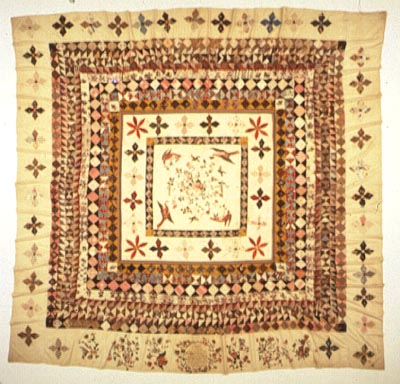Quilt No.958NGA - National Gallery of Australia

"Convict women made the quilt en route to Australia, in 1841, on board the Rajah. The ship left Woolwich on 5th April and arrived in Hobart 19th July �.. with 179 women prisoners. There were possibly twenty-nine convict women on board the ship who worked the quilt. Extensive information is held at the NGA on the details of the voyage and the women who were transported to Australia upon the Rajah." [NGA]
"Little is known of the past owners of the quilt. It is believed that the quilt was presented to a government official soon after the Rajah's arrival. In 1987 the quilt was discovered in a private collection in Scotland. In 1989 it was purchased and donated to the National Gallery of Australia by Les Hollings and the Australian Textile Fund" [NGA]
"The fabrication of the Rajah quilt was organised by prison reformer Elizabeth Fry and the 'British Ladies Society for the Reformation of Female Prisoners', who were all members of the Quaker religious order. A woman listed as a free passenger of the Rajah, Miss Kezia Hayter is conjectured to have been the supervisor of the creation of the quilt and the needleworker of the most skill in its fabrication; she probably did the inscription panel." [NGA]
"One of the border bands carries an inscription in very fine cross stitch (18 stitches/cm). The inscription reads:
TO THE LADIES Of the Convict ship committee This quilt worked by the Convict of the ship Rajah during their voyage to Van Diemans Land is presented as a testimony of the gratitude with which they remember their exertions for their welfare while in England and during their passage and also of proof that they have not neglected the Ladies kind admonitions of being industrious * June * 1841 *" [NGA]
Related Quilts:
1680 x 1380mm
2000 x 2200mm
2470 x 2100mm
[PHM] 1720 x 1150mm
1350 x 148mm
1880 x 1330mm






